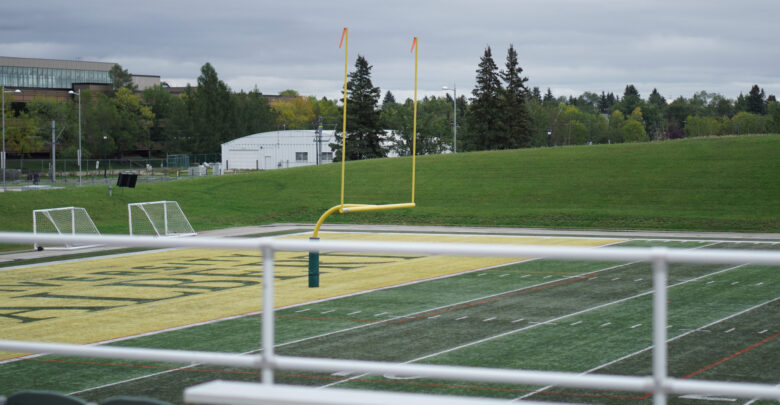 Jonas Smith
Jonas SmithIt’s the fourth quarter of a Golden Bears basketball game. Before this moment, I neither understood nor cared about the sport. But now, that doesn’t matter. I raise my hands into the air, yell something senseless at the referee, and wave my drink around. In this moment, my blood runs green and gold.
I am a 21-year-old student. I am something out of a college drama. I am at a university sports game.
My interest in the Golden Bears and Pandas emerged with one little number: $96.62, calling out to me from the fee assessment page of my BearTracks. This number is the Athletics and Recreation fee, included in tuition each semester for full-time students. This non-opt outable fee is paid by all on-campus students (part-time students see a reduced rate of $48.32). The fee, as the Office of the Registrar describes it, is used to support “sport, recreation, leisure, and physical activity services” at the University of Alberta.
According to the Mandatory Non-Instructional Fees Annual Report for 2021-22, students altogether paid about $6.386 million in Athletics and Recreation fees every year. Exactly half of this money — about $3.193 million — goes toward the recreation portion of the fee, funding the operation of “sport specific facilities” and “recreational programs and activities” that are accessible to all students.
The other half, however, goes toward the “administrative and coaching support requirements for Golden Bears, Pandas, and Vikings Athletics.” Or, to put it frankly, half of the $3.193 million students pay each year goes directly toward funding athletics — an investment that very few students (really, only the university’s 475 student athletes) directly benefit from.
Or do they? $96.62 could pay for a lot of things. New textbooks. Groceries. A portion of tuition. Why should this money go toward funding sports teams that only a minority of students play on? What do the rest of us get out of it?
These are the questions I had in mind when I sat down with Connor Hood, the U of A’s Sports Information Coordinator, and Katie Spriggs, the U of A’s Interim Director of Athletics. Hood and Spriggs, both self-proclaimed sports fanatics themselves, seemed acutely aware of the fact that not every U of A student shares the same interest. In fact, when asked to describe a Golden Bears or Pandas fan, both insisted that it was an impossible task.
“I don’t think you can put them in a box,” Spriggs explained. She described the crowd at the average Golden Bears or Pandas game: a three-year-old enthralled by Patches and GUBA, a crowd of friends seeking reprieve from a day of studying, an alumnus in his 90s sitting in his go-to spot.
Fans, it seems, span the whole range. While there are some attendants who, as Hood explained, are “truly just fans of that particular sport,” it seems that the motivation for attending a game rests less in athletic fluency and more in being a part of something bigger.
This observation is reflected in the field of sports psychology, which not only studies the psychological state of athletes, but of spectators, too. In fact, according to psychologist Daniel L. Wann in his book Sports Psychology, one of the reasons we seem to love sports so much is related to our self-esteem: the more we feel like we belong to an external group, the more our self-esteem increases, and the happier and more satisfied we feel.
Even if we personally lack athletic ability — or, for that matter, athletic interest — we still feel a sense of satisfaction and accomplishment when our favourite teams win. Furthermore, even if our favourite teams lose, we find comfort in the fact that we’re surrounded by fellow grieving fans. If you’re the type of person who doesn’t know the difference between a touchdown, a free-throw, and a power play — but you still find yourself in the stands — you might know exactly what Wann is describing.
Both Hood and Spriggs emphasized that this sense of belonging is enhanced by the fact that, when it comes to university sports, the players in question are our peers. When a Golden Bears or Pandas team makes the headlines, we can identify with the student athletes who succeed. They represent the U of A, but, in a certain sense, they represent all of us.
Still, all of the sentimentality in the world can’t change the fact that students pay a notable amount of money to the Athletics program each year. But, talking to Hood and Spriggs, I felt confident that this isn’t a responsibility that the program takes lightly — they work with the knowledge that most of the student body are not student athletes.
“We do have to get perspective sometimes,” Spriggs explained. In the Athletics Office, Hood and Spriggs are, of course, surrounded by sports fans. It would certainly be easy to assume that everyone feels just as invested. But this isn’t the case.
While, as Spriggs explained, you “don’t ever want to diminish people caring,” there is a balance to be held. Not every student is a sports fan. Thus, it’s important to consider the experience of all students on campus — not just those who have a vested interest in the game. As Spriggs put it, it’s vital to avoid “losing sight of the bigger picture,” especially when it comes to spending students’ money.
Writing this article, I realized that trying to answer the question “why do we care about sports?” is sort of like asking “why do we tell stories?” or “why do we create art?”
Sure, there are studies and research. But nevertheless, it seems like it derives from something much deeper and much more profound. Maybe it’s a bit of a cop-out to call it all human nature — to rest back on musings about what it means to be human, to be a part of a community, to belong to something — but I can’t help but think that it might be part of the answer.
“Seeing people from every single faculty, every part of campus, every type of person you could think of, just all blindly and passionately rooting for the same thing,” Hood said. “It’s hard to describe unless you’re there.”




